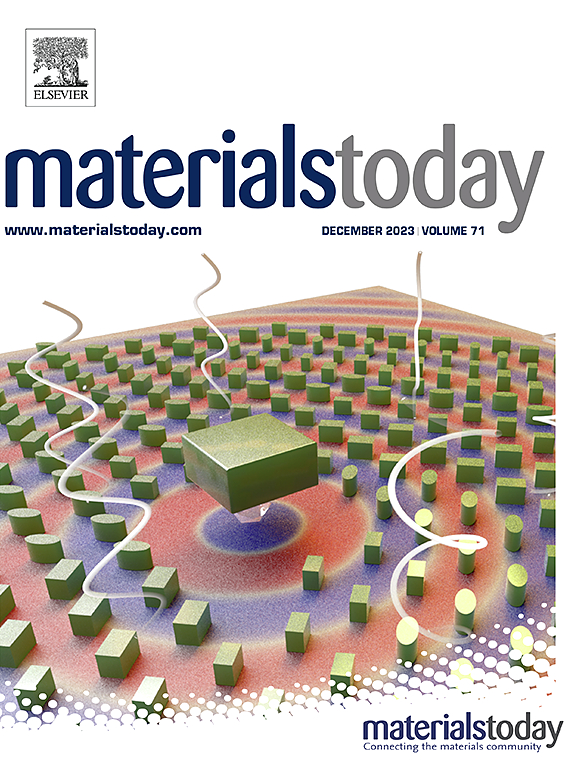超稳定Janus纳滤膜和粘合剂中多巴胺与二胺的界面聚合
IF 21.1
1区 材料科学
Q1 MATERIALS SCIENCE, MULTIDISCIPLINARY
引用次数: 0
摘要
多巴胺的聚合可以产生各种应用的自然灵感材料。聚多巴胺(PDA)通过沉积技术用于修饰亲水性表面;然而,它缺乏成膜能力。在本研究中,我们通过aza-Michael加成证明了多巴胺与二胺的界面聚合,从而形成了具有纳米到微米厚度的膜,后者具有Janus性质。通过实验和硅力学研究确定了二胺链长度、单体浓度、杂原子和溶剂介质对膜形成的影响。纳米膜在苛刻的有机溶剂、离子液体和强酸中表现出优异的稳定性。由PDA和生物质源原胺组成的5 nm厚的纳米膜具有可控的纳滤性能,具有26 L m−2 h−1 bar−1的N,N-二甲基甲酰胺溶剂渗透率和540-704 g mol−1的分子量截止值。并成功地应用于高温纳滤中。此外,纳米膜在具有不同润湿性和粗糙度特性的不同表面上表现出单面和双面粘附,包括木材和玻璃表面。本研究对pda -二胺独立膜的结构-性能关系、聚合机理、膜分离和粘接应用等方面进行了全面的了解。本文章由计算机程序翻译,如有差异,请以英文原文为准。
Interfacial polymerization of dopamine with diamines for ultrastable Janus nanofiltration membranes and adhesives
The polymerization of dopamine can yield nature-inspired materials for diverse applications. Polydopamine (PDA) is used for modifying hydrophilic surfaces via deposition techniques; however, it lacks film-formation ability. In this study, we demonstrate the interfacial polymerization of dopamine with diamines via aza-Michael addition, which results in the formation of films possessing thicknesses in the range of nano- to micrometers with Janus properties for the latter. Experimental and in silico mechanistic investigations were conducted to determine the effects of the diamine chain length, monomer concentration, heteroatom, and solvent medium on film formation. The nanofilms exhibited exceptional stability in harsh organic solvents, ionic liquids, and strong acids. A 5-nm thick nanofilm composed of PDA and biomass-derived priamine exhibited controllable nanofiltration performance, demonstrating a high N,N-dimethylformamide solvent permeance of 26 L m−2 h−1 bar−1 and molecular weight cutoff of 540–704 g mol−1. Furthermore, the membrane was successfully applied in high-temperature nanofiltration. Additionally, the nanofilms demonstrated single- and double-sided adhesion on diverse surfaces, including wood and glass surfaces, which possess different wettability and roughness characteristics. This study provides a comprehensive understanding of the structure–property relationship, polymerization mechanism, membrane separation, and adhesive applications of PDA–diamine freestanding films.
求助全文
通过发布文献求助,成功后即可免费获取论文全文。
去求助
来源期刊

Materials Today
工程技术-材料科学:综合
CiteScore
36.30
自引率
1.20%
发文量
237
审稿时长
23 days
期刊介绍:
Materials Today is the leading journal in the Materials Today family, focusing on the latest and most impactful work in the materials science community. With a reputation for excellence in news and reviews, the journal has now expanded its coverage to include original research and aims to be at the forefront of the field.
We welcome comprehensive articles, short communications, and review articles from established leaders in the rapidly evolving fields of materials science and related disciplines. We strive to provide authors with rigorous peer review, fast publication, and maximum exposure for their work. While we only accept the most significant manuscripts, our speedy evaluation process ensures that there are no unnecessary publication delays.
 求助内容:
求助内容: 应助结果提醒方式:
应助结果提醒方式:


